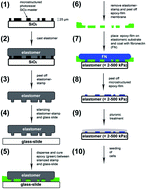Defined 2-D microtissues on soft elastomeric silicone rubber using lift-off epoxy-membranes for biomechanical analyses
Abstract
Surface patterning with complex molecules has become a valuable tool in cell biology and biotechnology, as it enables one to control cell shape and function in culture. However, this technique for micro-contact printing is normally performed on rigid substrates, e.g. Petri dishes or glass. Despite the fact that these substrates can easily be patterned they are artificially stiff environments for cells affecting their morphology and function. Those artifacts can be avoided on tissue elasticity resembling substrates, leading to a nature like cell morphology and behavior. However, reproducible patterning of very soft elastomeric substrates is challenging. Here, we describe a simple and highly accurate method through cavities of lift-off membranes for protein patterning of silicone rubber substrates in an elasticity range down to 1.5 kPa without altering their mechanical properties. Membranes are made of epoxy resin with feature sizes that can be chosen almost arbitrarily including widths down to 5 μm and aspect ratios of 100 and more. Different feature shapes were used to actively manipulate cell adhesion, cell morphology and the actin cytoskeleton on soft substrates. Manipulation of cytoskeletal organization furthermore allowed the comparison of myofibril alignment and cellular forces of cardiac myocytes. These data could show that cell forces are largely unaffected upon active disordering of overall myofibril alignment on a single cell level while aligned multicellular systems generate cell forces in an additive manner.

- This article is part of the themed collection: Proteins, cells, and tissues in patterned environments

 Please wait while we load your content...
Please wait while we load your content...